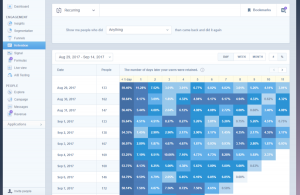
We often think about the e-commerce shopping experience as a journey from the homepage to checkout. As an e-commerce professional, you want to optimize each page on your site to guide a shopper further down that journey. But it’s important to remember that the e-commerce shopping journey is unique for each shopper. One shopper may start his journey on a PDP and go straight to checkout. Another may click from an email to a PDP, then find her way to the homepage, then to several category pages before finding a product she decides to purchase. Meanwhile, each shopper has unique interests and attributes, so different experiences will appeal to different people.
When it comes to personalization, think about each point of interaction on your site and how you can help individual shoppers achieve their goals at each point along the way. Personalize the homepage, PDPs, category pages, emails, and more based on everything you know about each person. This will allow you to create a relevant, individualized e-commerce experience for every shopper — regardless of what their unique journey looks like.
In this blog post, I’ll provide an example of a personalized experience you can provide at four points of interaction: the homepage, the category page, the cart page, and cross-channel.
Homepage
Getting the homepage experience right is a challenge for any type of website. You want it to be relevant to all visitors to capture their attention and encourage deeper exploration of the site. The homepage hero area is often the most eye-catching section of the page — so it’s a key piece of real estate.
Personalizing that area of the homepage can have a dramatic impact in driving clickthroughs and encouraging further engagement with the site. You can target different geolocations with different homepage content, feature each shopper’s favorite category, or tailor content to the visitor’s persona – just to mention a few ideas.
With its diverse shoe categories, Shoeline.com has many different types of shoppers with unique needs. The company delivers personalized homepage experiences to visitors based on their preferred categories. For example, a shopper who has engaged with the bowling shoe category may see a bowling-specific homepage hero and call-to-action. These experiences have resulted in clickthrough rates as high as 26%.

Category Page
Most shoppers on a category page are planning to navigate to a PDP. They may be looking for something specific or just browsing, but each of them will have a different idea of what will catch their attention. A static category page that is generic to everyone is a waste of an opportunity to be maximally relevant to all individuals.
One way to make the most of your category pages is to highlight the subcategories that are most relevant to each shopper to guide them to products that will interest them. Recommendations aren’t just for products, you can use machine-learning algorithms to dynamically promote the categories that match each visitor’s preferences.
For example, this site has a highly visual section on its category pages that it uses to recommend subcategories to shoppers. Each individual sees a different selection of subcategories depending on his or her preferences and behaviors across the site.

Cart Page
Personalized experiences don’t have to end once a person gets to the cart. A personalized experience on the cart page could be the push the shopper needs to complete the purchase and even increase basket size. One way to accomplish this is to use personalized messages or recommendations to alleviate shipping concerns. Recommend products (relevant to each individual) that can be purchased at no additional shipping cost or that the shopper can add to the cart to qualify for free shipping. You could even remind the shopper of any outstanding credits or loyalty points.
For example, this site adds an inline message to its cart page to recommend a relevant product to its shoppers at no additional shipping cost. The message is inserted seamlessly into the webpage, helping increase order value, like an online version of an impulse purchase.

Cross-Channel
Retailers often treat a shopper as a different person on different channels. But when you’re trying to build a relationship with your shoppers, the first step is to recognize them no matter which channel they use. The ability to unify your customer data across systems and platforms is critical to providing a great customer experience regardless of channel. When your data is unified, you can keep your messaging consistent across your website and mobile experience to remind visitors of abandoned carts, ongoing sales, outstanding loyalty points or credits, and more.
For example, by sharing data across platforms, Publishers Clearing House (PCH) is able to keep its personalized messages consistent across its several websites and across mobile and desktop. With its cross-platform, individualized reminder messages, PCH generated over $ 1 million in incremental revenue in just a 90-day period.

Final Thoughts
There is a lot of competition on the internet for consumers’ attention. It’s easy for a shopper to leave your site if she doesn’t find something relevant. Personalized experiences that tailor your site to the individual preferences and intent of each person are the best way to capture the attention of each shopper in their own individual journeys.
This post has included just a few examples of personalized e-commerce experiences. To learn more about how you can provide personalized experiences across the e-commerce shopping journey and discover more examples across each point of interaction, download our eBook, Individualized E-commerce: Great Examples of Real-Time Personalization.
Digital & Social Articles on Business 2 Community
(113)







